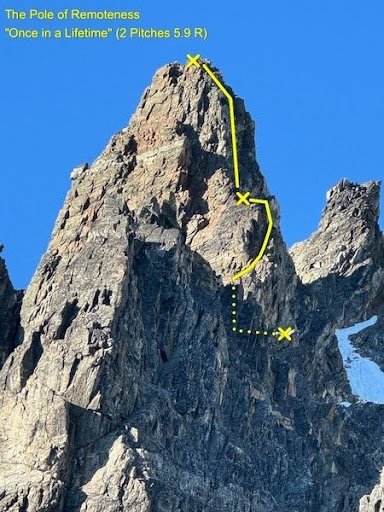Mt. Fury, West Peak, Mongo Ridge and New Variant on Pole of Remoteness
Washington, North Cascades, Pickett Range
 Throughout the first week of July, Adam “Mo” Moline and I completed the fourth ascent of Wayne Wallace’s Mongo Ridge (VI 5.10a, 2006). Our climb was supported by the AAC’s Live Your Dream Grant and represents the culmination of six climbing seasons in the North Cascades. In the 2023 American Alpine Journal, Sam Boyce wrote, “Wayne Wallace is a legend of the Cascades, and out of all his exploits, none may be more epic than his solo first ascent of the mile-long Mongo Ridge–the south ridge of Mt. Fury’s west peak–deep in the Northern Pickets.” Our efforts on Mongo are but a celebration of Wallace’s visionary first ascent.
Throughout the first week of July, Adam “Mo” Moline and I completed the fourth ascent of Wayne Wallace’s Mongo Ridge (VI 5.10a, 2006). Our climb was supported by the AAC’s Live Your Dream Grant and represents the culmination of six climbing seasons in the North Cascades. In the 2023 American Alpine Journal, Sam Boyce wrote, “Wayne Wallace is a legend of the Cascades, and out of all his exploits, none may be more epic than his solo first ascent of the mile-long Mongo Ridge–the south ridge of Mt. Fury’s west peak–deep in the Northern Pickets.” Our efforts on Mongo are but a celebration of Wallace’s visionary first ascent.
Along with repeating Wallace’s route, we established a new two-pitch variation on the Pole of Remoteness, which was named by Cascades historian John Roper, who speculated it might be the most inaccessible point in the Lower 48. The Pole had seen only two ascents: first by Wallace in 2006 via a bold, 100’ 5.7 pitch along the north side, then by Boyce and Lani Chapko, who repeated Wallace’s line in 2022 (theirs was the third ascent of Mongo Ridge). Our two-pitch contribution, which we dubbed Once in a Lifetime, had 220’ of 5.9 R and began near the base of the Pole, climbing a series of ramps on the southwest aspect of the formation.
To access Mongo Ridge, one must first summit East Fury, a major mountain in its own right, before descending nearly 4,000’ into the Goodell Creek basin to gain the base of Mongo Ridge’s first tower. Wayne’s original Mongo line ascends four towers (each between 300’ and 600’ tall), followed by an airy horizontal knife-edge traverse—“The Rooster Comb”—with difficulties up to 5.10. The complex, wandering nature of the route, which includes rappels from each tower, makes the possibility of retreat increasingly complicated.
Mo and I roped up for glacier travel and pitched everything out, including a few sections of long simul-climbing. We spent three nights on the route—bivying on the first and third towers, as well as on the false summit of West Fury—so as to avoid rushing and to prioritize safety through this difficult terrain. This decision, along with a splitter weather forecast, put us in a strong position to repeat the Rooster Comb, which both Jeff and Priti Wright (who made Mongo’s second ascent in 2021) and Sam and Lani bypassed. The Rooster Comb is accessed via a long pitch of loose 5.9 at the base of the fourth tower before it unfolds as a horizontal, airy traverse requiring careful movement. This is an inspiring section of ridge climbing that navigates a series of gendarmes whose shapes are reminiscent of the Fisher Towers in Utah.
From the end of the Rooster Comb, Mo and I rappelled climber's left to access a series of steep gullies that led us to the base of the Pole of Remoteness. A delicate, leftward 5.8 traverse across the skirt of the Pole brought me to the southern headwall, which I was able to follow on accommodating, if cerebral, 5.9 terrain to reach a belay ledge halfway up the formation. Mo took the second pitch, a sustained and steep 5.9 arête that only eased off at the top. The climbing was run-out, but we both found adequate protection and felt that the Pole of Remoteness was significantly less intimidating than the rest of Mongo Ridge.
After his and Priti Wright’s ascent of the route, Jeff Wright wrote that, “The first ascent [of Mongo] is one of the legendary, mythical ascents of the Cascades and even of the climbing world.” After experiencing the ridge for ourselves, Mo and I wholeheartedly agree.
—Emilio Taiveaho Peláez

